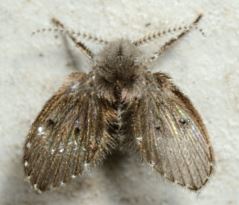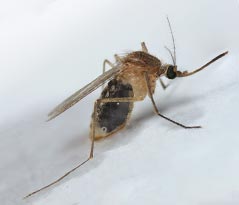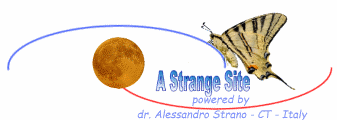
probably Limonia maculipennis (Meigen, 1818)

Nephrotoma sp
femmina / female / hembra
foto / photo by / fotografía Alessandro Strano
L'addome delle femmine termina a punta. La specie più grande di questa famiglia è la Tipula maxima (Poda, 1761) con una apertura alare di circa 6,5 cm, mentre quella più comune è la Tipula oleracea (Linnaeus, 1758) (lunga sino a 2,3 cm, di colore grigiastro). Le specie del genere Nephrotoma hanno il corpo lucido, spesso nero con macchie gialle. Le zampe sono molto lunghe e sottili nelle specie del genere Dolichopeza.
The abdomen ends in a pointed shape in females. The biggest species of this family is Tipula maxima (Poda, 1761) with a wingspan of about 6,5 cm, while the most common species is Tipula oleracea (Linnaeus, 1758) (up to 2,3 cm long, greyish). Species of genus Nephrotoma have a polished body, usually black with yellow marks. Legs are very long and slender in Dolichopeza species.
El abdomen es apuntado en las hembras. La especie más grande de esta familia es Tipula maxima (Poda, 1761) con abertura de las alas cerca de 6,5 cm, mientras que aquélla más común es Tipula oleracea (Linnaeus, 1758) (larga hasta 2,3 cm, grisácea). Las especies del género Nephrotoma tienen el cuerpo luciente, usualmente negro con manchas amarillas. Las patas son muy largas y sutiles en las especies del género Dolichopeza.

Tipula sp
maschio / male / macho
foto / photo by / fotografía Alessandro Strano

Bibio johannis (Linnaeus, 1767)
maschio e femmina / male and female of March fly / macho y hembra
foto / photos by / fotografías Alessandro Strano

Bibio siculus (Loew, 1846)
maschio e femmina / male and female of March fly / macho y hembra
foto / photos by / fotografías Alessandro Strano
In questa specie (0,7-0,8 cm) le femmine hanno l'addome arancione. Tra le altre specie si ricordano: Bibio marci (Linnaeus, 1758) (1-1,3 cm, femmine nere), Bibio hortulanus (Linnaeus, 1758) (0,8-1 cm, femmine arancioni). Le specie italiane di questa famiglia appartengono a due soli generi, Bibio (tibie anteriori con lunghe spine) e Dilophus (tibie anteriori con corte spine disposte ad anello). I maschi volano tenendo le zampe verticalmente ed hanno occhi molto grandi. In questa specie le zampe presentano delle aree rosse.
In this species (0,7-0,8 cm) females have orangish abdomen. Among the other species there are: Bibio marci (Linnaeus, 1758) (1-1,3 cm, females are black), Bibio hortulanus (Linnaeus, 1758) (0,8-1 cm, females are orangish). Italian species belong to the genus Bibio (front tibiae with long spurs) and Dilophus (front tibiae with short spurs forming a ring). Males fly keeping their legs vertically and have very big eyes. In this species legs have some red areas. bands.
En esta especies (0,7-0,8 cm) las hembras tienen el abdomen anaranjado. Algunas de las especies más comúnes son: Bibio marci (Linnaeus, 1758) (1-1,3 cm, hembras negras), Bibio hortulanus (Linnaeus, 1758) (0,8-1 cm, hembras de color anaranjado). Las especies italianas pertenecen al género Bibio (tibias anteriores con largas espinas) y Dilophus (tibias anteriores con espinas cortas dispuestas como un anillo). Los machos volan con las patas a plomo y tienen ojos muy grandes. En esta especie las patas tienen áreas rojas.

Dilophus probably bispinosus (Lundstroem, 1913)
femmina / female of March fly / hembra
foto / photos by / fotografías Alessandro Strano

Molte specie di questa famiglia inducono la formazione di galle in varie piante.
Many species of this family make galls on various plants.
Muchas especies de esta familia hacen agallas en varios vegetales.

Molte specie di questa famiglia inducono la formazione di galle in varie piante.
Many species of this family make galls on various plants.
Muchas especies de esta familia hacen agallas en varios vegetales.

Mycetophilidae (sensu lato)
(mosca dei funghi/fungus gnat)
foto / photo by / fotografía Alessandro Strano

Mycetophilidae (sensu lato)
(mosca dei funghi/fungus gnat)
foto / photo by / fotografía Alessandro Strano

Mycetophilidae (sensu lato) more likely Keroplatidae
(mosca dei funghi/fungus gnat)
foto / photo by / fotografía Alessandro Strano

(mosca dei funghi/fungus gnat)
foto / photo by / fotografía Alessandro Strano

Clogmia albipunctata (Williston, 1893)
(mosca dello scarico / moth fly / mosca de la polilla)
foto / photo by / fotografía Alessandro Strano
Specie di piccole dimensioni (0,3-0,5 cm), predilige le zone umide ed ombrose ricche di sostanze organiche in decomposizione. Le larve si nutrono di alghe, funghi e batteri; gli adulti anche di nettare. Vedi anche le note sulle specie simili.
This species is small (0,3-0,5 cm long), it likes wet shady places where can find organic substances in decomposition. Larvae feed on algae, mushrooms and bacteria; adult insects feed on nectar too. See also the note about similar species.
Esta musca es muy pequeña (0,3-0,5 cm), vive en puestos húmedos y umbrosos. Las larvas se nutren de algas, holgos y bacterias; los adultos también de néctar. Ver también las notas sobre las especies semejantes.

Phlebotomus sp
(pappataci / sandfly)
Le femmine della sottofamiglia Phlebotominae, come ad esempio Phlebotomus papatasi (Scopoli, 1786), sono ematofaghe e possono trasmettere malattie (in genere, vedi foto, queste specie a riposo tengono le ali rivolte in alto come una V).
Females of the subfamily Phlebotominae (generally, when at rest, these species keep their wings upwards just like a V, see the photo), such as Phlebotomus papatasi (Scopoli, 1786), feed on blood and can transmit diseases.
Las hembras de la subfamilia Phlebotominae, como Phlebotomus papatasi (Scopoli, 1786), se nutren de sangre y pueden transmitir dolencias (generalmente, ver la fatografía, estas especies tienen las alas sobre el cuerpo como una V cuando están reponidas).

Sylvicola probably fenestralis (Scopoli, 1763)
(window gnat - identification by Andrew Whittington)
Catania, 18/05/2005
foto / photo by / fotografía Alessandro Strano
Questa foto documenta probabilmente per la prima volta la presenza di una specie della famiglia Anisopodidae in Sicilia. Questa foto è stata pubblicata a p. 13 del n. 60 della rivista Quark (gennaio 2006).
Probably, this photo records for the first time the presence of a species of Anisopodidae in Sicily. This photo was published at page 13 of Quark no. 60 (January 2006).
Probablemente esta fotografía documenta por la primera vez la presencia de una especie de la familia Anisopodidae en Sicilia. Esta fotografía fue publicada a la página 13 del numero 60 del periódico Quark (enero 2006).

foto / photo by / fotografía Alessandro Strano

Aedes albopictus (Skuse, 1894)
(femmina e maschio di zanzara tigre / female and male of Asian tiger mosquito / hembra y macho de mosquito tigre)
Catania 27/09/2006
foto / photo by / fotografía Alessandro Strano
Questa è una specie (una sola fascia chiara sul centro della parte superiore del torace) originaria dell'Asia, ma ormai presente in molte altre aree. Nel 2005 è stata osservata anche in Sicilia. Simile è Aedes aegypti (Linnaeus, 1762) (due fasce chiare). Vedi anche le note sulle altre specie.
This species (only one clear band in the middle of the upper side of the thorax) is native of Asia, but nowadays it is present in many other regions. In 2005 it was observed in Sicily too. Similar species is Aedes aegypti (Linnaeus, 1762) (two clear bands). See also the notes about the other species.
Esta especie (solamente una faja clara en la midad de la parte superior del tórax) es nativa de Asia, pero hoy día es difusa en muchas otras zonas. En el 2005 fue observada también en la Sicilia. Especie muy semejante es Aedes aegypti (Linnaeus, 1762) (dos fajas claras). Ver también las notas sobre las otras especies.




Culex pipiens (Linnaeus, 1758)
femmina di zanzara, uova, larva e pupa / female of mosquito, eggs, larva y pupa / hembra de mosquito, huevos, larva y pupa
foto / photos by / fotografías Alessandro Strano
La zanzara comune, Culex pipiens, è lunga sino a 0,5 cm. Le femmine (i maschi hanno le antenne piumose) succhiano il sangue dell'uomo, dei mammiferi e di altri animali, insetti compresi; le larve sono acquatiche. Un'altra specie comune è Culiseta annulata (Schrank, 1776). Nelle specie del genere Anopheles lo scutello non è trilobato e nelle femmine i palpi mascellari sono lunghi circa quanto la proboscide, nelle altre specie lo scutello è trilobato, nel genere Aedes mancano le setole pre-spiracolari e gli artigli delle zampe anteriori sono dentate, nel genere Culex mancano le setole pre-spiracolari e quelle post-spiracolari mentre presentano i pulvilli ed in molte specie il primo articolo dei tarsi posteriori è più lungo della tibia, nel genere Orthopodomyia mancano i pulvilli ed il primo tarso delle zampe anteriori è più lungo dei quattro distali considerati insieme, nel genere Coquillettidia mancano i pulvilli ed il primo tarso delle zampe anteriori non è più lungo dei quattro distali considerati insieme, nel genere Uranotaenia la squamula è senza peli.
Common mosquitoes, Culex pipiens, are up to 0,5 cm long. Females (males have plumose antennae) suck blood from man, mammals and other animals, insects included; larvae are aquatic. Another common species is Culiseta annulata (Schrank, 1776). In the species of genus Anopheles the scutellum has not three lobes and in females the maxillares palpes are almost as long as the proboscid, in the other species the scutellum has three lobes, in the genus Aedes there are no pre-spiracolar bristles and claws of foreleg are toothed, in the genus Culex there are no pre-spiracolar bristles and no postspiracular bristles while pulvilli are present and in many species the first segment of hind tarsi is longer than tibiae, in the genus Orthopodomyia there are no i pulvilli and the first segment of anterior tarsi is longer than the four distal segments considered together, in the genus Coquillettidia there are no pulvilli and the first segment of anterior tarsi is not longer than the four distal segments considered together, in the gebus Uranotaenia the squamule is not haired.
Son las hembras (los machos tienen antenas plumosas) que chupan la sangre de los hombres, de los mamíferos y de otros animales, insectos incluidos; las larvas son acuáticas. Una otra especie común es Culiseta annulata (Schrank, 1776). En las especies del género Anopheles el escutelo no es trilobulado y en las hembras los palpes maxilares son largos acerca la trompa, en las otras especies el scutello es trilobulado, en el género Aedes faltan las cerdas pre-espiraculares y las uñas de las patas anteriores son con dientes, en el género Culex faltan las cerdas pre-espiraculares y las cerdas post-espiraculares mientras hay los pulvilli y en muchas especies el primero artículo de los tarsos posteriores es más largo que la tibia, en el género Orthopodomyia faltan los pulvilli y el primero segmento de los tarsos anteriores es más largo que los cuatro distales juntos, en el género Coquillettidia faltan los pulvilli y el primero segmento de los tarsos anteriores no es más largo de los cuatro distales juntos, en el género Uranotaenia la escama no tiene pelos.

Culiseta annulata (Schrank, 1776)
Femmina di zanzara / female of mosquito / hembra de mosquito
foto / photo by / fotografía Alessandro Strano
Questa specie è marrone, le zampe hanno fasce nere e bianche e le ali sono chiazzate. L'esemplare nella foto è lungo circa 0,7 cm. Una specie molto simile è Culiseta subochrea (Edwards, 1921) (ali distintamente meno chiazzate). Vedi anche le note sulle altre specie.
This species is brownish, legs have white and black stripes and wings are spotted. The specimen in this photos is about 0,7 cm long. A very similar species is Culiseta subochrea (Edwards, 1921)(wings are less distinctly spotted). See also the notes about the other species.
Esta especie es marrón, las patas tienen fajas blancas y negras y las alas son manchadas. El esemplar en la foto es largo acerca de 0,7 cm. Una especie muy semejante es Culiseta subochrea (Edwards, 1921)(alas distintamente menos manchadas). Ver también las notas sobre las otras especies.


femmina e maschio / female and male / hembra y macho
(Biting midge)
Le femmine di questa famiglia si nutrono di sangue e possono pungere anche l'uomo. Le antenne dei maschi sono piumose.
Females in this family feed on blood and can bite man too. Males have plumose antennae.
Las hembras de esta familia se alimentan de sangre y pueden picar también al hombre. Los machos tienen las antenas plumosas.

maschio / male / macho
foto / photo by / fotografía Alessandro Strano
Le specie di questa famiglia somigliano un po' alle zanzare, ma l'apparato boccale è meno sviluppato e comunque non sono ematofaghe. Le antenne dei maschi sono piumose.
Species of this family look a bit like mosquitoes but mouth parts are less developed and they do not feed on blood. Males have plumose antennae.
Las especies de esta familia semejan a los mosquitos mas el aparato bucal es menos desarrollado y no se nutren de sangre. Los machos tienen las antenas plumosas.

femmina / female / hembra
foto / photo by / fotografía Alessandro Strano

larva
foto / photo by / fotografía Alessandro Strano

foto / photo by / fotografía courtesy as shown
